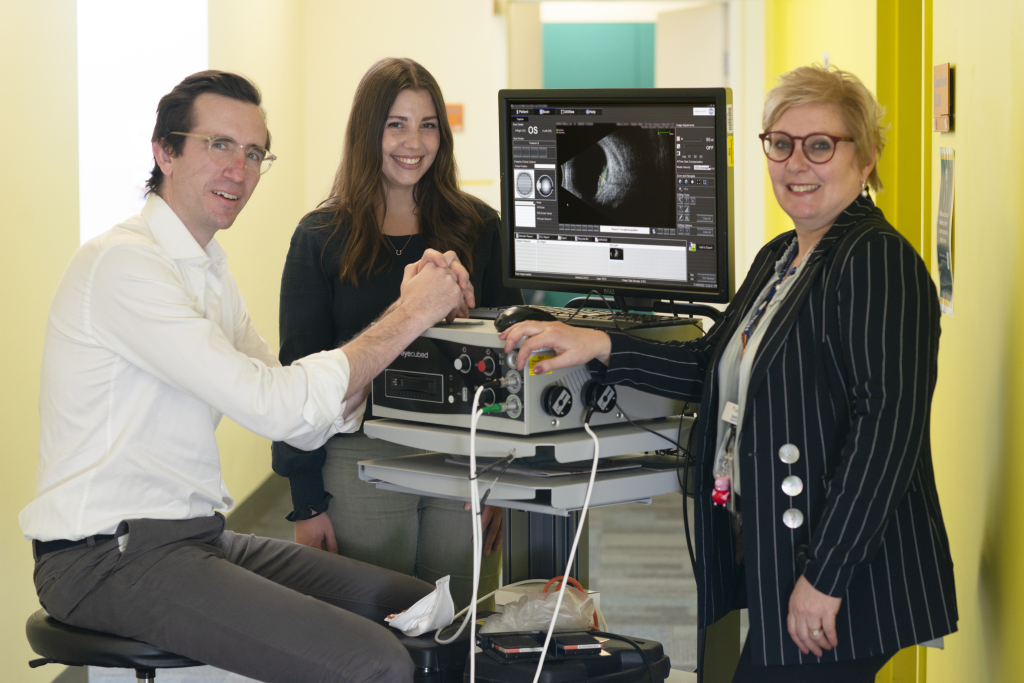Retinoblastoma is a rare form of eye cancer, usually diagnosed in children under the age of five years. The tumours develop in the retina which is located at the back of the eye and can grow to fill much of the eyeball; diagnosed late or left untreated, the cancer spreads to other areas of the body including the brain and spine.
The diagnosis of retinoblastoma in children can be devastating, as many parents are faced with the difficult decision to either remove the eye immediately, known as enucleation, or undertake other treatment options if safe to do so. Chemotherapy, focal therapy (heating or freezing treatment applied directly to the tumours) and radiotherapy can be undertaken with the aim of saving the eye, however they all come with a range of challenging and life-long side effects. Despite all eye saving treatments, sometimes, enucleation is required to save the child’s life.
Thanks to support from the Professor Frank Billson Research Scholarship, Orthoptist Dr Sandra Staffieri AO, who is also the Retinoblastoma Care Coordinator at The Royal Children’s Hospital (RCH), is helping parents feel empowered to make the best choice for their children when faced with this situation.
“For parents whose children have been diagnosed with advanced retinoblastoma in one eye, which occurs in around 60 per cent of patients, the treatment options can be confronting,” said Sandra.
“Parents will often say, how do I explain to my child when they’re older that we made a choice to remove their eye? But it can be really hard to explain to families the burden of going down the path of trying to save the eye, and the likelihood of success.”
“Treatment to save an eye is intensive and can require the child to undergo an examination under anaesthetic monthly in their first year of treatment alone. All up, children who have treatment to save an eye could have up to 30 operations before their fifth birthday, whilst a child who has an enucleation at the time of diagnosis will likely only require four or five operations,” she added.
As one of the inaugural scholarship recipients, Sandra’s work will compare the outcomes for children diagnosed with unilateral retinoblastoma in Victoria who received treatment to save their eye, versus those whose eyes were removed.

Dr Sandra Staffieri (right) with her ophthalmologist colleague, Dr Rod O’Day and medical intern, Dr Lily Rolfe
Using a retrospective audit, Sandra along with medical intern Dr Lily Rolfe and ophthalmologist colleague Dr Rod O’Day, will examine the clinical records of all children diagnosed with sporadic, unilateral retinoblastoma from January 1998 to December 2020.
For each patient diagnosed with what is known as Group D or E unilateral retinoblastoma, Sandra and her team will look at data including demographics, initial clinical examination, imaging and the stage of retinoblastoma at diagnosis. Importantly, they will also examine the outcomes following treatment, including number of examinations under general anaesthetic or hospital admissions following initial diagnosis, treatment complications and how frequently trying to save an eye was successful.
“This project will hopefully mean that when we’re sitting down with a family and giving them the diagnosis that their child has eye cancer, we can ensure they have a clear understanding and appreciation of what the burden associated with treatment to save the eye actually is and are as informed as they can be to make the best decision for their child,” said Sandra.
According to Sandra, the Professor Frank Billson Research Scholarship is an investment in the future of children’s eye health, and receiving it feels empowering.
“Making a change to improving children’s vision isn’t just about the people doing the research or thinking up the research questions. It’s about the people who actually enable that to happen, the donors, and it is really validating to receive funding for a research project because it tells you that somebody else thinks the work you do is important. For me, it is like the donors are part of our research team, because what we do isn’t possible without them.”
“I also feel like there is a kind of symmetry with Frank and my work. He was a co-author on the very first retinoblastoma research paper that was ever written on an Australian cohort,” Sandra said.
“When I first began working at the RCH, about seven years after Professor Frank Billson AO left, I would see his handwriting on medical records. So, it feels particularly humbling all these years later to be the recipient of a scholarship named in his honour. I feel privileged to continue his legacy and to support the next generation of Ophthalmologists in delivering world leading research and care.”
“Working with Lily, I can now pay forward everything that I’ve been taught about research. It’s now my opportunity to supervise the next generation of researchers, and to fill them with the passion of wanting to find these answers – to improve care and outcomes. Because when we do research, it’s not about knowing something for the sake of knowing it. It’s about what impact the research is going to have on others,” she added.
“On behalf of everyone in the Department of Ophthalmology, and the patients we care for, we want to share our sincere thanks and gratitude to Shelley Kline and her community for helping make this scholarship possible, and for truly advancing the outcomes of children with blinding eye disease. Thank you!” said Sandra.
Donate to the Professor Frank Billson Research Scholarship